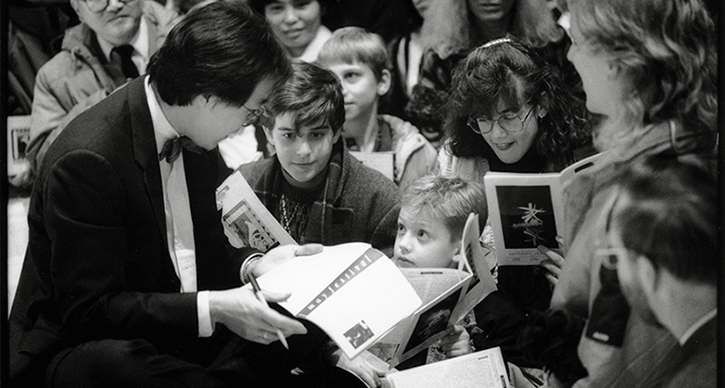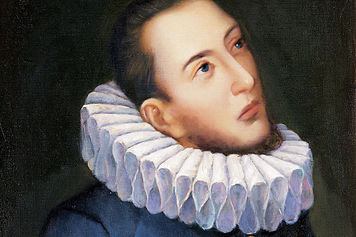Yo-Yo Ma and the Silk Road Project: Musical Journeys

Photo: Yo-Yo Ma sits on the stage and autographs programs for students at Hill Auditorium in 1991.
With their March 16 concert at Hill Auditorium, Yo-Yo Ma and the Silk Road ensemble receive the 2013 UMS Distinguished Artists Award, and Yo-Yo Ma is a name known to almost anyone even casually acquainted with classical instrumental music. Sheer longevity has helped Ma to this point—his performing career began in 1961, at the age of six, and he has an instinct for connecting with general audiences that was second nature to the great virtuosi of the past but isn’t seen so much anymore.
Yet this Parisian-born, Chinese-descended, and for all that thoroughly American cellist has reached a level beyond mere popularity. “Distinguished artist” covers it pretty well. How did he get here? Few would nominate him on purely technical grounds; he does everything well that he needs to, but it’s a keen ear that can identify his playing from its sound alone. Audiences are quick to respond to his personal warmth, and no one should discount that. But it’s a quality he shares with many other musicians.
Most artists follow trends, a few even set them. But rare indeed are the ones like Ma for whom each individual concert is part of a larger, even a lifelong utterance. Yo-Yo Ma’s music brings ideas from a hundred years ago, and it explores others that are absolutely new, and in which he is indeed a pioneer. His music-making carries with it history of ideas, and in this lies its enduring appeal.
Something entirely new in the history of concert music
The Silk Road Project, an incarnation of which appears at UMS’s March 16 special event, was founded in 1998. It’s something entirely new in the history of concert music: not really an ensemble, for as an ensemble it is always changing. Instead, it’s an organization, a framework for collaboration, an ongoing series of programs and educational enterprises—in a word, an idea.
The Silk Road, which also had an important maritime component, was a network of trade routes connecting Asia, the Mediterranean, and Africa from antiquity until the Renaissance era. It was a conduit for much more than silk and other luxury goods, bringing, for a start, Buddhism to China, ancient Greek art to Central Asia and points east, and Indian religions and finally Islam to Indonesia. Why do statues of the Buddha look Greek? The artistic ramifications of these developments, stretching over more than a millennium, are countless, and each new Silk Road Project recording or performance brings the feeling that the surface has only been scratched.

Image courtesy of UNESCO.org.
The Silk Road Project is indeed something new, yet it’s something old as well. It’s difficult for modern audiences to put themselves in the place of those in the late nineteenth century, when lines between classical and popular music were not so firmly drawn, and when a virtuoso was often a player who brought a whiff of exotic lands. With the Silk Road Project, Yo-Yo Ma is in part reflecting on his own heritage and on the many cultures in its orbit. Classical music has always relied on the physical presence of the virtuoso to keep it in touch with the music of the wider world and avoid losing itself in insular delusions of linear progress, and looked at in one way, Ma is the heir to a musician like violinist Pablo de Sarasate, whose repertory traced a semicircle from Spain to Venice Eastern Europe around classical music’s increasingly Germanic core.
Sarasate performs:
Yet, for all that, Yo-Yo Ma is a product of the idealistic middle twentieth century, when classical music seemed able to spread a kind of enlightenment. He made his name not with Asian music but with Bach’s suites for solo cello, following the mold of an artist whose influence on him has been a bit obscured by the fact that their styles are different: Pablo Casals. Ma played under the 90-year-old Casals in the Marlboro Festival Orchestra in Vermont, and Casals went on, at 95, to write a Hymn to the United Nations (with text by W.H. Auden), and Yo-Yo Ma numbers among his honors that of official United Nations Messenger of Peace.
A Hymn to the United Nations:
The Silk Road Project rests on this foundation of idealism. It has been the major artistic decision of Yo-Yo Ma’s middle age, and it weaves together strands of culture from wide ranges of space and time. Each Silk Road Ensemble concert brings something of exotic cultures, of classical idealism, and of new world fusions, yet each one is different. As an explorer of world music Ma is unusual and fresh; as a visionary who sees how world music relates to the classical tradition and its capacity for historical reflection, he is a unique treasure. He has a keen eye for talent, a healthy disregard for genre, and a willingness to try new things that is nothing short of marvelous in the later stages of a classical career. Distinguished, indeed.
Gesualdo: Rebel or Rogue? [with Audio]

On February 16, at 7:30 p.m. at St. Francis of Assisi Church, the University Musical Society presents the Tallis Scholars. This British group of about ten singers has spawned a whole industry of a cappella ensembles that aspire to sonic purity, contemplative calm, timelessness. What could the Tallis Scholars—Scholars!—possibly have to do with this season’s Pure Michigan Renegade Series, of which they are a part?
Let’s start with the gruesome facts associated with the composer at the center of the night’s program. Carlo Gesualdo (1566?–1613), the nephew of Counter Reformation enforcer Carlo Borromeo, was a prince and landholder in Venosa in southeastern Italy. Around 1588 his wife, the noblewoman Donna Maria d’Avalos, began an affair with a gentleman in the vicinity. In 1590 Gesualdo, using wooden copies of room keys he had had made, found the pair in bed together, stabbed them both, and hung their corpses in front of his castle for all to see. The story was retold repeatedly by poets of the day in a sixteenth-century equivalent of headline news.
Gesualdo, as a nobleman, was immune to prosecution, although he had plenty to fear from the relatives of his wife and her lover. He was never arrested, but he spent most of the rest of his life either on the road, investigating new musical developments, or, later on, locked up in his castle, writing music for concerts at which he himself was the audience.
The madrigals he wrote during his later years lay buried for three hundred years, but they fascinated musical modernists who unearthed them. Filled with hyper-expressive settings of texts about searing jealousy and betrayal, they seemed to push the boundaries of dissonance that was possible under the rules of Renaissance polyphony, and to anticipate music that was centuries in the future. The first performers of the madrigals, in fact, were mostly not early music specialists but the group of performers led by Robert Craft, the prominent American champion of Igor Stravinsky’s music.
Gesualdo wrote less sacred music, but the Tenebrae Reponsories (“tenebrae” means “shadows” and refers to Christian services celebrated in the days before Easter; a responsory is a setting of a text that contains an answering section) that he composed at the end of his life are among his very greatest works. In these pieces the thorny question of how Gesualdo’s life and music are related reaches an especially sharp point. Consider this setting of “O vos omnes” composed by Gesualdo in 1611, two years before his death:
“O vos omnes qui transitis per viam, attendite et videte si est dolor similis sicut dolor meus,” says the responsory text—”O you who walk down the road, pay attention and see whether there is any sorrow like my sorrow.” The text comes from the Lamentations of the Prophet Jeremiah and originally described the sack of Jerusalem in the sixth century B.C.E. It was repurposed for the Passion story. But it’s hard not to think of Gesualdo himself as the subject when the words “similis sicut dolor meus” are repeated in tonal regions unthinkably distant from the piece’s home base.
*****
Was Gesualdo really a renegade as well as a murderer? Was he even a “modernist” of his time? Some would say no — his chromaticism did not lead to a new language but only explored the strangest corners of an old one. The truly new music of the first decade of the 1600s was opera, which he did not touch. Gesualdo’s music was closed up in an emotional hothouse, and one word that’s been used to describe it is Mannerist — looked at from a certain angle, the jarring contrasts in his works were musical equivalents of El Greco’s light and shade. Or perhaps his artistic counterpart was Giuseppe Arcimboldo, the Italian who painted surreal human heads made up of vegetables, plants, and even books.
Photo: Giuseppe Arcimboldo’s Vertumnus.

What is a renegade, anyway? Does change in the arts come from an avant-garde, or does it bubble up from below? Do musical traditions tend to shock most when they begin, or when they’re coming to an end?
Whatever your ultimate answers to these questions may be, the music of Don Carlo Gesualdo has lost none of its ability to shock as it enters its fifth century of existence. If you’ve never heard Gesualdo at all, or if you know him only through the few tortured madrigals that circulate among college singing groups, hear how the language of his last years was refracted through sacred texts in the magnificent Tenebrae Responsories, somber Holy Week thoughts from a prince whose life and music intertwined in profound ways.


